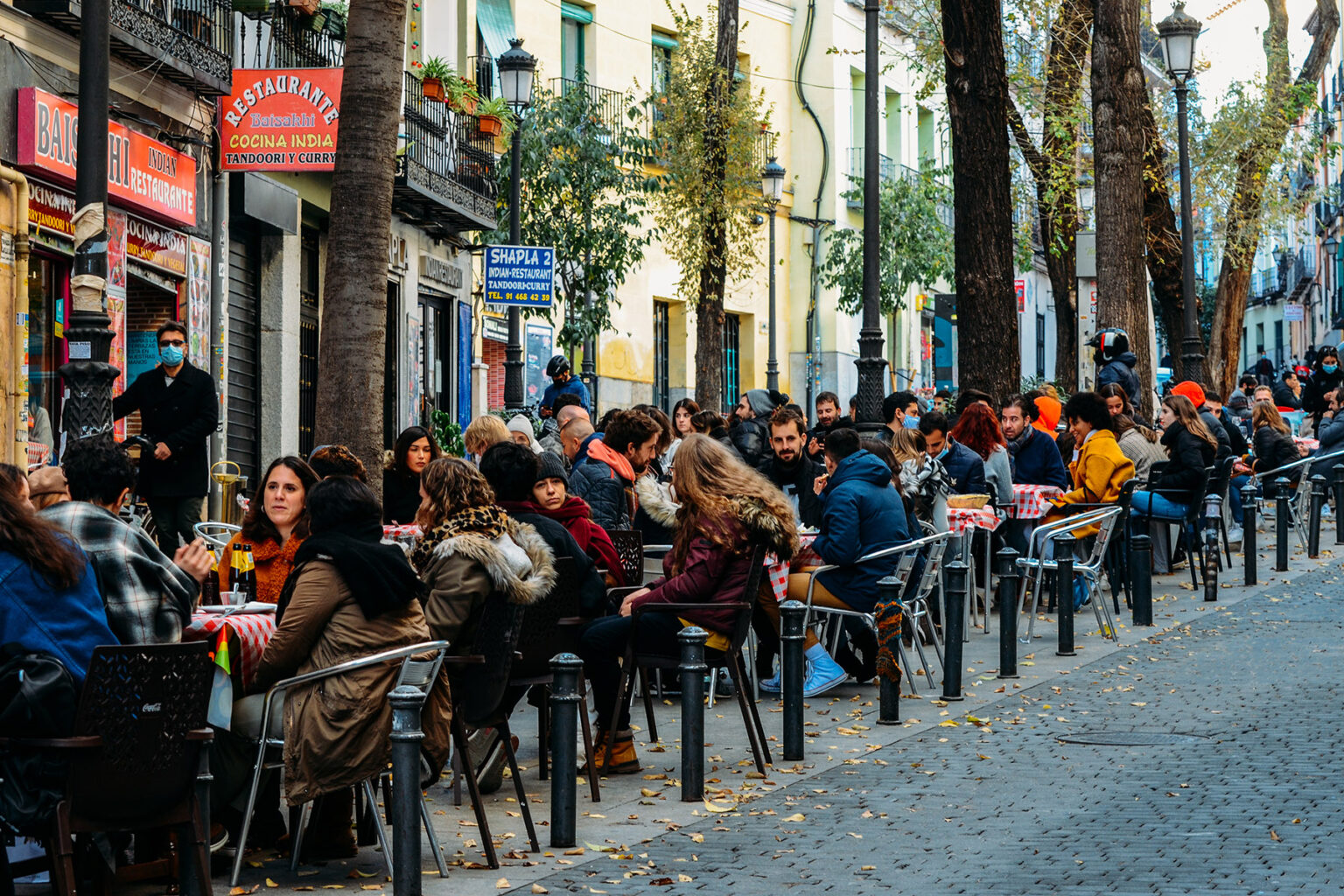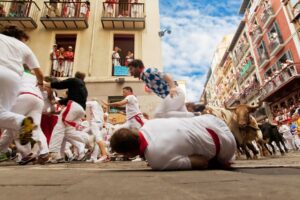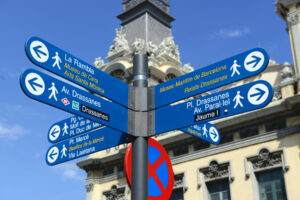There is an opening scene taking place in Seville in Mission Impossible 2 (2000) that is hilarious for its many inaccuracies about Spain, Seville, and its local Spanish festivals. For example, for some reason the Semana Santa (Holy Week) procession has falleras and fire, which are traditions of Valencia’s non-religious Fallas bonfire festival not Seville’s very-Catholic Holy Week.
The flamenco scene that follows in the movie is perhaps a bit better (flamenco is actually from the Sevilla region), but it reproduces a common myth about Spain that is, though more subtle, much more pervasive and intractable, that all Spanish people have dark eyes and dark (thick and straight) hair.
Let’s dive in:
Spotahome
Looking for somewhere to rent in Spain? Spotahome takes the hassle out of househunting by doing the hard work for you. Their online platform lets you find, view, and book rental properties all from the comfort of your own home. Take the stress out of househunting in Spain with Spotahome.
The typical Spanish look
The image of Spanish people as dark eyes, dark hair and speaking with a thick lisp is quite old. As early as 1846 the English writer Richard Ford was encouraging others to find ‘a more worthy subject [in Spain] than the old story of dangers of bull-fights, bandits, and black eyes‘ [my emphasis added]. And it must be tied to Andalucía’s predominance in images of Spain abroad.
In Hemingway’s time, the embodiment of this stereotype was Rudolph Valentino, perhaps the original Latin lover, who though Italian by birth was cast in a whole assortment of nationalities in Hollywood films in the 1920s, among them as the bullfighter Juan Gallardo in Blood and Sand (1922).
A tacky tourist industry for very staged, Valentino-style flamenco shows sprouted up in Andalucía in the 20s leading Hemingway to spurn the region and to prefer the more ‘authentic’ bullfighting experiences of Madrid, Navarra and the Basque Country.
Even today, I think Spanish actresses who physically fit this Spanish mold are more likely to be ‘exported’ to film industries abroad. Take Madrid-born Penélope Cruz, for example, who represents a similar dark eye, dark hair Castilian look.
And while I can say much more about it than I will here, Americans greatly exaggerate a lisp in Castilian Spanish. The hard ‘th’ sound (called the ‘ceceo‘) used to pronounce the ‘c’ and ‘z’ is officially never used to pronounce ‘s’.
Andalucía
Andalucía is the only region in Spain where some people do so, no doubt further evidence of the region’s central place in the imagination of Americans; though there are also areas in Andalucía where Spanish pronunciation more closely resembles Latin American Spanish, and the ‘c’ and ‘z’ all become an indistinguishable ‘s sound.
But returning to physical stereotypes, the reality in Spain is quite different.
There are vast regional differences and variations in hair type and eye colour. Fair skin, blue and green eyes, light brown, blond and even red hair is common in many regions. For example, in Alicante many people have distinctively green eyes and in the northern regions, such as the Basque Country and Asturias, it is common to find Spanish people who would be hard to distinguish from our common stereotypes of northern Europeans. This is not to mention the light brown and wavy hair that is characteristic throughout the Mediterranean regions.
Andalusian actress Paz Vega, who probably best represents the classic dark eyes, dark straight hair Andalusian look.
And what nature hasn’t diversified, international fashions and migration have.
Were I to re-edit that scene in Mission Impossible 2, I would be sure to dye almost everyone’s hair blonde. The popularity of bleaching or dying one’s hair in Spain is such that you might think everyone in the country was blonde or burgundy.
Moreover, Spain has a lot of immigration, almost even with US in terms of per capita, and much of that immigration, from Romania and certain countries in South America and Africa, hardly fits the Castilian or Andalusian dark eyes, dark hair stereotype.
So chalk this one up to yet another Romantic misconception about Spain we seem unable to shake.
Personal space
We North Americans (and others out of Anglo-Saxon origins) hold our personal space sacred. Mediterranean Europeans are much more physical. They stand closer, speak closer and touch each other more; they hug and kiss and shake hands with perfect strangers; and God forbid you expect an Anglo-Saxon to adjust to personal space norms in a place like Brazil, which is even closer than southern Europe.
The touching and closeness is a very human way to be and can be looked at as group inclusiveness, which we all have a strong need for. But the downside is that outside of greeting and chatting and having closeness kindly directed at you, it is taken for granted that involuntary touching, bumping and even pushing is nothing that needs to be avoided.
People barge right past you in Spain without so much as an ‘excuse me’ or ‘may I pass?’ or even ‘sorry!’ In fact, most people refuse to move aside from your trajectory, either forcing you off the sidewalk into an oncoming group of people or, if you hold your line and do what they do – which is not move out of the way – bump right into you as they elbow their way through the crowd without so much as an acknowledgement.
My own prejudices vs my own observances
When I first moved here, I thought this was because Spanish people were horribly rude. The ricocheting off other people, coupled with never smiling at strangers (a blank stare or look up and down is normal – which I have adopted, but that is another story) made me feel like I was in a sea of angry, bitter people who just didn’t care who they mowed over to get where they wanted to go.
But even though I still want to scream when people walk three- or four-wide on a sidewalk essentially taking up the whole damn thing – this is super common with the older ladies here who even link arms to fully block any passage from behind – shoving my way through a crowd can be liberating when I get in the right frame of mind.
You see, no one cares here if you whack them with your bag, elbow them aside, or shove them ever so gently so you can pass while they stand in the path of traffic. It is expected. So when you do let out a little aggression on one of the seven burly dudes coming at you, maybe leaning into one of them a little too firmly with the shoulder, well, they don’t care. No one ever turns around and says, “Hey buddy, watch who you are shoving”. They just keep chatting and lean into it along with you.
I realise that may not be the best example – it’s a cultural thing that may be considered rude or normal, depending on from whence you hail, though it is unlikely to be considered a pet peeve by anyone. But I included it here because 1) it’s entertaining 2) it goes along with the theme of ‘one man’s inconsiderateness is another man’s normal behaviour’. I’ll put myself in the spotlight next.
Speak louder
I know that I drive some people crazy because I speak very softly. I know this because people frequently say ‘what?’ to me after I say something. Or they more rudely might ask, “Are you talking to yourself?” or even, “What are you mumbling?”, which leads me to believe they might be a tad annoyed. One would logically assume that I would just talk louder, but I really do have a quiet-ish voice and to project it takes a lot of effort.
After a couple of hours of speaking at a level that, to me, is loud, I am exhausted. It’s like singing to an audience for hours. Add to it that my hearing is really sensitive – a lot of times it seems to me like people are yelling when they are speaking – and you have someone who isn’t going to change her quiet world for the sake of anybody, especially not for those who ask me what I am mumbling instead of just saying they didn’t hear me. (Ironically, I have met other people who speak really low or, yes, mumble, and guess what? I find it annoying.)
Interrupting others
Outside of the misuse of their, they’re and there, my biggest peeve has to be when someone talks over me. You know, when you are talking or finishing a sentence and someone just starts talking, forcing you to either stop or speak louder to drown them out? Turns out either way you lose, because then you are so annoyed you’re no longer thinking about the subject but about how the person just cut you off mid-sentence.
Guess what? Interrupting others is totally acceptable in certain places, too. Anglo-Saxons wait for each other to finish before speaking, and take turns holding the floor. Mediterraneans generally just talk as their thoughts occur and speaking at the same time is totally acceptable. I am telling you, the reality TV here is incomprehensible, with 5 to 10 people frequently talking (or yelling, I am not sure which, since a lot of talking sounds like yelling to me) over each other for up to three minute stretches. I personally don’t think this makes for good TV, but I don’t think anyone here cares because the TV here sucks.
So my point with all of this is? You can’t take things at face value when you are in a place you are unaccustomed to. This seems obvious, but until you understand why you consider something unacceptable, you might just write off a place or a people before you really know them.
Spanish stereotypes
1. Everyone speaks Spanish
There are actually four languages in Spain:
- Castilian (Castellano)
- Catalan (Catalán)
- Basque (Euskera)
- Galician (Gallego)
Castilian is what the English-speaking world calls Spanish — you will primarily hear it referred to as Castellano by Spanish people, although some still refer to it as Español. This confused me for my first week or two living in Spain, and all the people who asked me ‘¿Hablas Castellano?‘ got completely blank stares from my end. Castellano has a markedly different accent from that of Latin American Spanish, most easily distinguished by the pronunciation of the letter ‘c’ as ‘th’.
Catalan comes from the northeastern region of Catalonia, of which Barcelona is the capital. It is the co-official language along with Castellano. While everyone from Barcelona understands Spanish, they will likely respond to you in Catalan. Many restaurant menus and signs however, remain in Spanish or consist of both languages.
Basque is spoken in the northern Basque Country region of Spain, and some parts of Navarra, another autonomous region in the north. Well-known Basque cities include the gastronomical capital San Sebastian, and Bilbao, which houses the Guggenheim Museum. While plenty of signs, menus, and posters around the major Basque cities are in the Basque language, you will still hear plenty of people speaking Spanish; there’s no need to fret about trying to pick up Euskera as a visitor. The language itself isn’t Latin-based so it’s vastly different from the other dialects in Spain.
People speak Galician in Galicia, the northwestern region of Spain right above Portugal. It is the co-official language in the region along with Castellano.
2. Spanish food is spicy just like Mexican food
Spanish food is completely different from Mexican or any other Latin American cuisine. Hot sauce is not common in Spanish cooking, not even as a condiment. The bottles of hot sauce at supermarkets are bland in comparison to the spiciness of Mexican dishes. Most Spanish people I know do not (and cannot) eat spicy food.
3. All Spanish people love bullfighting
Bullfighting is certainly one of Spain’s long-standing traditions and draws enormous crowds, but its popularity has slowly declined — and controversiality risen — in light of burgeoning movements against animal cruelty. It is illegal in the Canary Islands. It’s also illegal in Catalonia in 2010, though partly for political reasons.
These days, the sport is most popular mainly in the south of Spain, the region around Madrid, and the northern region of Navarra. This is where perhaps Spain’s most famous festival, the San Fermín (Running of the Bulls) festival, runs in Pamplona every July.
Given all that, the average Spaniard has likely never been to a bullfight. As for the residents of Pamplona, many locals actually leave town around San Fermín in July, having developed a distaste for the influx of tourists and price hikes in restaurants and bars.
4. Catalonia is just a unique cultural area of Spain
Strictly speaking, this is true, but Catalonia possesses and takes far more pride in its own cultural and political identity than other regions of Spain. Many Catalans now think of themselves as a separate nation; in fact, there are ongoing Catalan separatist movements that favor secession from Spain.
The region has autonomy in Spanish history, dating from when Spain became a republic; however, its identity was later heavily oppressed by the Franco dictatorship.
5. Tapas are a classic Spanish food
Tapas are not an actual Spanish dish; it’s just a general word that refers to the small plates or appetizer-sized dishes in Spain. Larger portions, typically for sharing, are raciones (rations or portions).
In the northern regions of Spain including Navarra and Basque country, tapas are even called by a different name: pintxos. It is essentially the same concept, although pintxos are typically served on a slice of bread.
6. You can eat paella everywhere
Actually, paella specifically originates from Valencia, so head there if you want the most delicious and authentic paella of your life. But Spanish people in other regions of Spain do not commonly eat paella on a regular basis. When the dish is served in Catalonia and other various regions of Spain, it’s likely catering to tourists.
7. You can expect everyone to take a siesta in mid-afternoon
Before moving to Spain I had a very traditional perception of Spanish life, in which everyone would be asleep every day from 2–5pm. But having lived here for a while now, I have realized that the popularity of siestas depends heavily on the city and time of the year.
The main point of siesta is to rest during the hottest hours of the day (and after a heavy lunch), so it makes the most sense to take siestas in the summer — particularly in the blazingly hot southern region of Spain.
In smaller cities, the tradition of siesta is also more palpable. Not to mention, many banks close at 2pm and don’t reopen until the next day. But in major cities such as Barcelona and Madrid, siesta doesn’t seem to affect city life too much. Most shops, restaurants, and services are open all day. Only more traditional bars or restaurants still close during the afternoon.







